Island of Iona – Seabed Water Supply Pipeline (2017)
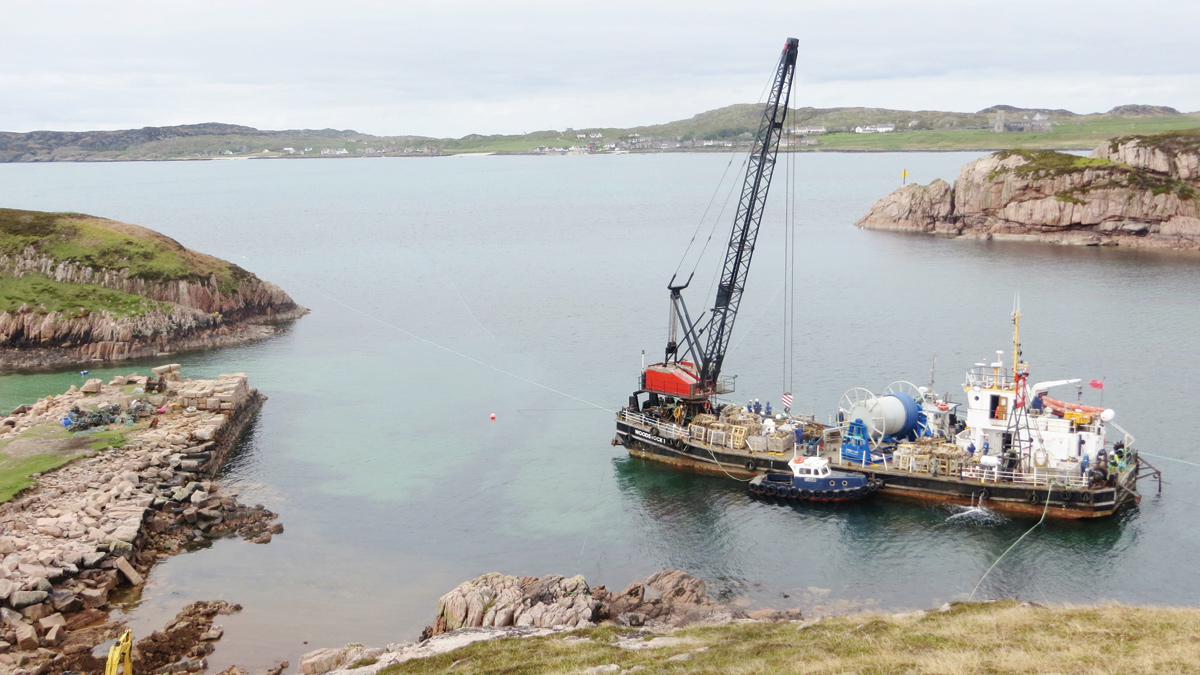
MV Woodstock approaching the Mull connection - Courtesy of George Leslie Ltd
The small island of Iona itself lies off the Isle of Mull in the Inner Hebrides off the west coast and is widely regarded as the birthplace of Christianity in Scotland. To the current day, Iona and its monastery has been a renowned centre of religious learning and pilgrimage and the Abbey is one of the most elaborate and best-preserved ecclesiastical buildings surviving from the Middle Ages. At only 1.5 miles wide by 3 miles long, the entire island remains an area of significant archaeological sensitivity with buried remains and artefacts charting the island’s history stretching back over fourteen hundred years. Thus the design and construction of any works on Iona demands the utmost respect for this heritage.
Background
The island has an indigenous, resident population of 120 which rises to over 500 during the summer months, augmented by over 150,000 day-visitors over the course of a busy summer. To maintain the island’s characteristics, the five minute ferry crossing from Mull is restricted to carrying foot passengers and only residents of Iona can take their vehicles onto the island with visiting vehicles requiring a special permit. Thus Iona also presents challenging logistics when it comes to mobilising plant materials and equipment to undertake construction works of any scale.
History of Iona’s water supply
Until 1990, Loch Staoineig was the sole source of the island’s mains water supply and at that time the water authority of the day embarked upon a multi-million pound project to replace this limited, island-based supply with an ambitious plan for a seabed pipeline across the Sound of Iona from neighbouring Mull. The project involved the construction of a feeder reservoir on Mull at a designed syphon level to deliver treated water through the seabed pipeline to a new 100m3, reinforced concrete service reservoir built on the hillside above the old Abbey on Iona.
This design and build contract was awarded to George Leslie Ltd who specialise in both pipeline and marine works. The 1.4km sea crossing comprised twin 90mm HHPE pipes encased within a 300mm diameter steel sleeve covered with flexible concrete mattresses. The whole works were completed in December 1994 at a cost of £1.3m and the twin pipeline encased in their steel sleeve remained in effective use until recent water quality and supply problems became apparent.
Investigations identified that one of the twin 90mm diameter pipes had burst at several locations and the damaged main was immediately isolated to restore a clean supply to the island. This, however, left only a single 90mm diameter operational pipeline with no back-up supply and an increased risk of being unable to cope with the peak summer demand.
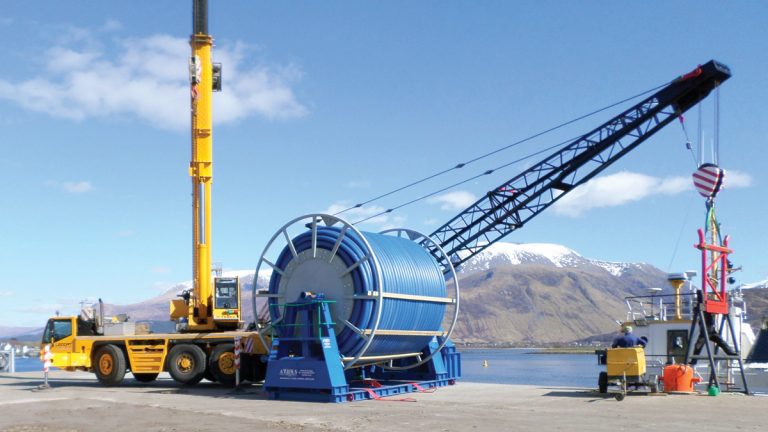
Spooled pipeline ready for loading – Courtesy of George Leslie Ltd
Pipeline replacement works
The Sound of Iona sea-crossing between Mull and Iona is subject to strong tidal currents and high seas during stormy weather and a robust permanent solution was required to reinstate, secure and augment the island’s water supply with a new pipeline. A seabed sonar survey was undertaken to identify the optimum positioning of the new route, with a new 125mm diameter HPPE pipeline itself to be encapsulated within articulated cast-iron, interlocking, short-length, ‘clamshells’. This solution allowed the new pipeline to articulate over the rocky seabed near the shores whilst providing additional weight to enable embedment into the sandier seabed conditions further offshore.
To minimise the impact on the narrow single-track roads on Mull, the pre-coiled HPPE pipe from Aliaxis UK (formerly GPS PE Pipe Systems), clamshells from CPNL Engineering Ltd and other materials were delivered to a quayside loading area on the mainland at Corpach near Fort William. Here, the pipe-lengths were butt-welded and pressure tested, wound onto a pre-fabricated drum in a single continuous length and pre-loaded onto the MV Woodstock workboat crane-barge, which then set sail down Loch Linnhe before rounding the north-east of Mull and onwards down to Iona.
Working off MV Woodstock, the pre-coiled pipeline was attached to the new connection chamber on the island before sailing across the Sound, attaching the protective clamshells and playing-out the pipeline as the vessel progressed. Throughout this operation, pipe-laying was controlled by GPS to ensure accurate barge mooring and pipeline positioning to the optimum route identified from the sonar survey. MV Woodstock itself is a self-propelled crane barge with 36t of lift and a large deck-space loading and work area and with on-board accommodation it was well-suited for the planned, continuous pipe-laying methodology.
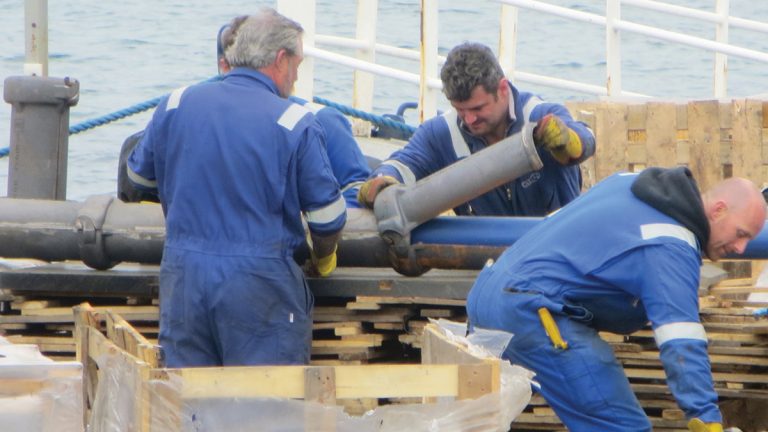
Fitting the clamshells onboard MV Woodstock – Courtesy of George Leslie Ltd
Working on Iona
Undertaking construction works in a remote location with such a historical heritage as the Island of Iona presents specific challenges particularly in ensuring that disruption and disturbance are minimised within the close, tight-knit community, not the least of which is accessing the work site. The larger Island of Mull is reached by a 45min crossing on a roll-on, roll-off ferry from the coastal town of Oban and this is followed by a 35 miles trip along a single-track road with numerous narrow bridges to Fionnphort from where a second ferry leaves on the 10min crossing to Iona itself.
Just over one year prior to commencing the new seabed pipeline work, George Leslie Ltd had undertaken a substantial, reinforced concrete reconstruction of the lower 20m tidal section of the slipway on Iona. To mobilise the necessary heavy plant and craneage on that occasion, a Caledonian MacBrayne vehicle ferry was chartered, loaded on the mainland and delivered the equipment direct to the slipway, thus removing heavy traffic from the islands’ road network.
Adopting a similar approach for the seabed pipeline, using the crane barge as the principal method of conveyance of material and equipment, gave reassurance within the local community that potentially disruptive interfaces were being effectively managed. Previous experience of working on Iona had demonstrated the importance of delivering construction projects in a manner which minimised any adverse impact on the busy tourist trade.
New connection chambers were constructed at Fionnphort on Mull and at Port an Diseart on Iona – where particular care was exercised to ensure there was no disturbance to important archaeological remains, with the new pipeline connected into the existing reticulation pipework of both islands.
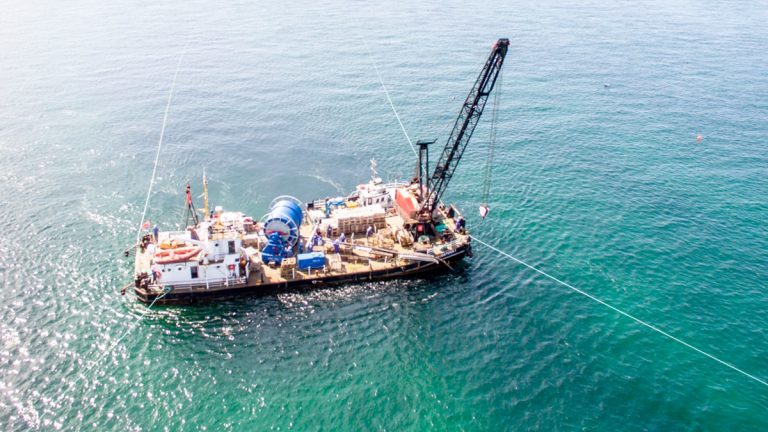
Mooring lines securing the barge by GPS positioning – Courtesy of George Leslie Ltd
The pipeline made landfall on Iona to the north of the legally-protected area associated with the Abbey with the connection chambers constructed at locations which had been proven as historical-find free areas. Thus with extensive investigation and pre-planning of the landfall areas together with careful execution in laying the new seabed main adjacent to the sole remaining supply main, George Leslie Ltd ensured minimal disturbance on the islands and maintained an uninterrupted supply.
Essential to the successful delivery of the Iona Seabed Water Supply Pipeline project was the extensive consultation which was undertaken with Marine Scotland, Scottish Natural Heritage, Historic Environment Scotland and the Community Council on Iona.
This consultation ensured that both the workplace environment was fully appreciated and understood and the risks associated with undertaking potentially intrusive works were effectively managed in this sensitive and historic location.
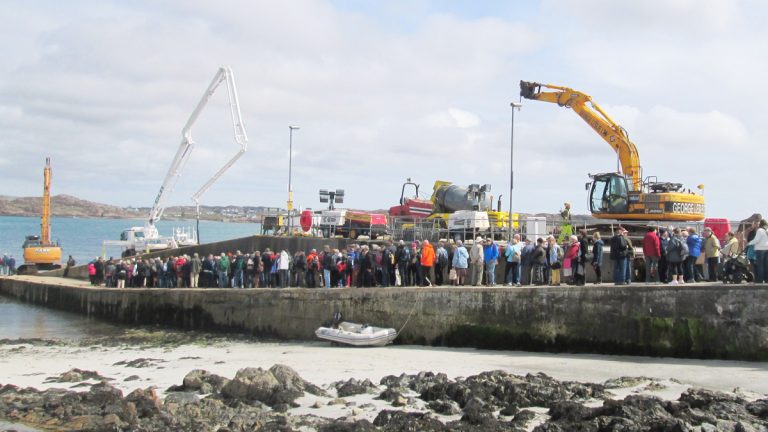
Busy tourist traffic during the slipway reconstruction – Courtesy of George Leslie Ltd
Conclusion
The new seabed water supply main has improved both the resilience and quantity of the water supply and reduced the risk of bursts affecting the customers on the island.


